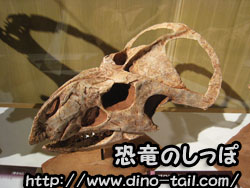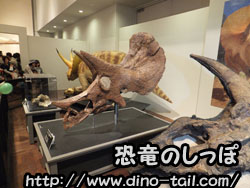First Ceratopsid Tooth Found in Japan
2013-02-23
It has been revealed that a fossil of a ceratopsid, a type of horned dinosaur, was discovered in Late Cretaceous strata (about 80 million years ago) on Shimo-Koshiki Island in Satsumasendai City, Kagoshima Prefecture. It was reportedly "found during an excavation survey in November 2011."
This is the second discovery of a horned dinosaur in Japan, following one in Hyogo Prefecture in 2009, but it is the first discovery of a ceratopsid, which had well-developed horns.
The discovery was a part of a tooth root, measuring 12.1 mm in length, 8.6 mm in height, and 3.7 mm in thickness. The fact that a single tooth had two roots and its shape confirmed it as a ceratopsid.
Horned dinosaurs found in Asia are often genera "without horns," such as Psittacosaurus and Protoceratops, making the discovery of a ceratopsid with developed horns a rare event.

*Note the lack of horns.

*Note the well-developed horns.
New Species of Pachycephalosaur Discovered in Canada
2013-05-11
A new species of dinosaur with a thick skull has been discovered in Late Cretaceous strata (about 85 million years ago) in Alberta, Canada.
The discovery was announced on May 7 by a research team from the Royal Ontario Museum and other institutions.
It is estimated to be about 1.8 meters long and weigh 40 kg.
Although a small herbivorous dinosaur, the top of its skull was over 10 cm thick.
Like Pachycephalosaurus, it is classified under Ornithischia - Marginocephalia - Pachycephalosauria, and was named Acrotholus (meaning "high dome" in Greek).
A Family? Three Triceratops Found in the USA
2013-06-08
Fossils of three Triceratops have been discovered at the same location in Late Cretaceous strata (about 67 million years ago) in Wyoming, USA. A rancher discovered them, and paleontologist Peter Larson and a team from the Black Hills Institute were notified to conduct the excavation.
Finding fossils of multiple Triceratops individuals together is unprecedented.
The largest of the three had tooth marks on its leg, believed to be from a "carnivorous dinosaur."
It is thought to have fallen prey to a Tyrannosaurus or other predator that lived at the same time.
The second individual was slightly smaller, and the third was about half the size.
It is possible they were a family, but this is not certain.
Edmontosaurus Had a "Comb" on Its Head
2013-12-14
A research team from the University of New England in Australia has announced that "Edmontosaurus had a rooster-like 'comb' on its head."
A skull fossil of an Edmontosaurus discovered in Late Cretaceous strata in western Canada had mummified soft tissue remaining, which was found to be a "comb" about 33 cm long.
The function of the "comb" is not well understood, but a researcher on the team commented, "It may have been for attracting mates or for displaying strength and size." In a few years, dinosaur books may depict Edmontosaurus with a "comb."
